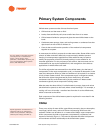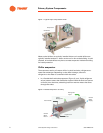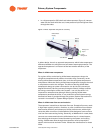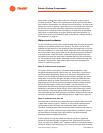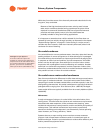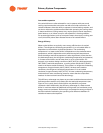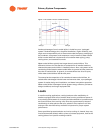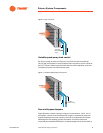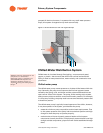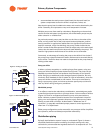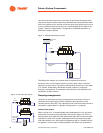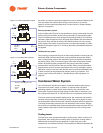
6 Chiller System Design and Control SYS-APM001-EN
Primary System Components
Low-ambient operation
Air-cooled chillers are often selected for use in systems with year-round
cooling requirements that cannot be met with an airside economizer. Air-
cooled condensers have the ability to operate in below-freezing weather, and
can do so without the problems associated with operating the cooling tower
in these conditions. Cooling towers may require special control sequences,
basin heaters, or an indoor sump for safe operation in freezing weather.
For process applications, such as computer centers that require cooling year-
round, this ability alone often dictates the use of air-cooled chillers.
Energy efficiency
Water-cooled chillers are typically more energy efficient than air-cooled
chillers. The refrigerant condensing temperature in an air-cooled chiller is
dependent on the ambient dry-bulb temperature. The condensing
temperature in a water-cooled chiller is dependent on the condenser-water
temperature, which is dependent on the ambient wet-bulb temperature.
Since the design wet-bulb temperature is often significantly lower than the
dry-bulb temperature, the refrigerant condensing temperature (and pressure)
in a water-cooled chiller can be lower than in an air-cooled chiller. For
example, at an outdoor design condition of 95°F [35°C] dry-bulb temperature,
78°F [25.6°C] wet-bulb temperature, a cooling tower delivers 85°F [29.4°C]
water to the water-cooled condenser. This results in a refrigerant condensing
temperature of approximately 100°F [37.8°C]. At these same outdoor
conditions, the refrigerant condensing temperature in an air-cooled
condenser is approximately 125°F [51.7°C]. A lower condensing temperature,
and therefore a lower condensing pressure, means that the compressor
needs to do less work and consumes less energy.
This efficiency advantage may lessen at part-load conditions because the dry-
bulb temperature tends to drop faster than the wet-bulb temperature (see
Figure 4). As a result, the air-cooled chiller may benefit from greater
condenser relief. Additionally, the efficiency advantage of a water-cooled
chiller is much less when the additional cooling tower and condenser pump
energy costs are considered. Performing a comprehensive energy analysis is
the best method of estimating the operating-cost difference between air-
cooled and water-cooled systems.






